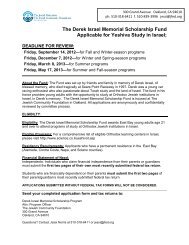East Bay Jewish Community Study - Jewish Federation of the ...
East Bay Jewish Community Study - Jewish Federation of the ...
East Bay Jewish Community Study - Jewish Federation of the ...
You also want an ePaper? Increase the reach of your titles
YUMPU automatically turns print PDFs into web optimized ePapers that Google loves.
There are few differences by age in participation in <strong>Jewish</strong> life — younger Jews are as likely to<br />
have a Passover Seder or light <strong>the</strong> Chanukah candles as older Jews. In fact, <strong>the</strong>y are more<br />
likely to report that <strong>the</strong>y attend <strong>East</strong> <strong>Bay</strong> <strong>Jewish</strong> events at least once a year than older Jews and<br />
<strong>the</strong>y are also more likely to volunteer. Again, <strong>the</strong>se differences are likely driven by <strong>the</strong> fact that<br />
younger Jews are more likely to have young children. The biggest difference between older and<br />
younger Jews is that younger Jews are 10 points more likely to always or usually have a<br />
Christmas tree.<br />
Figure 78: Younger Jews More Likely to Have a Christmas Tree<br />
I am going to read you a list <strong>of</strong> things that some people do. For each one, please tell how <strong>of</strong>ten you generally do it –<br />
always, usually, sometimes or never – Have a Christmas tree during <strong>the</strong> Christmas season. (Percent who say always/<br />
usually )<br />
100<br />
80<br />
60<br />
40<br />
42<br />
32<br />
20<br />
0<br />
18-49 Over 50<br />
83




